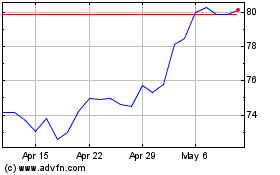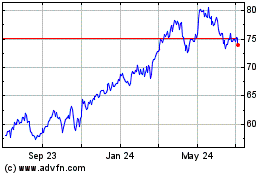By Leslie Scism and David Benoit
American International Group Inc. reached a settlement with
activist investors, averting the possibility of a proxy fight at
the insurance giant.
AIG will add billionaire investor John Paulson and Samuel
Merksamer, a top lieutenant of Carl Icahn, to its board at the 2016
annual meeting. The board will expand to 16 members.
The announcement came as AIG released fourth-quarter results.
The global insurer posted a $1.84 billion loss on a previously
announced strengthening of claims reserves while increasing its
common-stock dividend and buyback program.
AIG shares edged up 0.6% to $50.81 after hours.
AIG Chairman Douglas M. Steenland said the two new board members
would "bring financial and business expertise to the board, and we
look forward to benefiting from their insights as we move forward
with our strategy to create a leaner, more profitable and focused
AIG."
AIG's board is almost entirely populated by people recruited
after the U.S. government agreed to its 2008 bailout, since fully
repaid. Many were picked based on willingness to challenge
management.
A representative for Mr. Paulson's Paulson & Co. hedge fund
said the firm would have no comment.
Messrs. Icahn and Paulson have for months criticized AIG's
structure and performance, urging the company to break up. AIG has
resisted that call and said it was better off with its life and
property and casualty insurance units together, though it also
unveiled steps to shrink itself in coming years.
Mr. Icahn had said he would seek board seats and called for more
changes than had been announced. A deadline to launch a proxy fight
loomed this weekend.
In a statement Mr. Icahn said he himself declined to go on the
board in favor of Mr. Merksamer.
"We commend the board for adopting a number of our
recommendations over the last few months," Mr. Icahn said.
"We continue to believe that smaller and simpler is better and
look forward to working collaboratively with the board and
management to help catalyze a turnaround" in the company's core
property and casualty operations and shed the company federal
designation as a systemically important financial institution.
AIG Chief Executive Peter Hancock committed on Jan. 26 to a
wide-ranging set of initiatives to improve financial results,
including returning at least $25 billion of capital to shareholders
over the next two years, as an alternative to the dramatic split
envisioned by the billionaire investor.
AIG said Thursday that its board approved a 14% increase in the
quarterly dividend to 32 cents a share. That brings the annual
payout to about $1.53 billion, based on the company's share count
as of Dec. 31.
In addition, the board approved new share repurchases of $5
billion, on top of $800 million in an allocation that remains from
last year.
From Jan. 1 through Feb. 11, AIG had bought back $2.5 billion of
shares, so with the higher dividend and full use of the buyback
allocations, the company is on track to return nearly $10 billion
this year with the measures in place. The company said it returned
$11.7 billion in capital in 2015, between buybacks and
dividends.
In the wake of AIG's strategy update last month, the importance
of the fourth-quarter earnings has receded. At that time, Mr.
Hancock surprised investors with the announcement of a plan to
strengthen reserves by $3.6 billion before taxes, or about 6% of
AIG's total net loss reserves. The increase applies to a wide range
of policies sold over many years, from more than a decade ago
through 2014.
Mr. Hancock also promised improvement in profit metrics over the
next two years, through more-aggressive cost cutting and exiting
some business-insurance segments.The fourth-quarter results include
$222 million, before tax, of restructuring charges.
The reserve strengthening and restructuring charge created a
fourth-quarter loss of $1.84 billion, or $1.50 a share, compared
with net income of $655 million, or 46 cents a share, in the
year-earlier quarter.
Results also were hurt by lower net investment income, as low
interest rates have persisted on the high-quality bonds AIG favors,
and the slice of the investment portfolio allocated to hedge funds
also produced lower returns, the company said.
The company posted a fourth-quarter operating loss of $1.3
billion, or $1.10 a share, compared with operating income of $1.4
billion, or 97 cents a share, in the year-earlier quarter.
In the insurance industry, analysts focus on operating results
because they exclude realized gains and losses on insurers' big
investment portfolios. Analysts were expecting AIG to post an
operating loss of 93 cents a share. Some of the gap stemmed from
worse-than-expected results in the company's business of selling
car and home insurance.
Mr. Icahn has advocated breaking apart AIG's three main
insurance businesses--life, property-cans-casualty and mortgage--a
move he said would help AIG escape new federal regulations and
boost shareholder returns. Mr. Hancock has maintained the benefits
of being a conglomerate far outweigh the regulatory burdens, though
he wants to narrow AIG's focus through selected divestitures.
Last month, the company announced a planned initial public
offering of up to 20% of its mortgage-insurance unit and the sale
of a financial-advisory business. In the fourth-quarter earnings
release, it said it sold $2.1 billion of assets during the period,
including some shares of a Chinese insurer.
AIG was the recipient of one of the biggest U.S.- government
bailouts during the financial crisis. To repay the nearly $185
billion rescue package, it sold dozens of businesses and shrank by
about half, to just over $500 billion in assets. As the government
exited the scenes, the spotlight turned to AIG's high costs and
below-average profit margins.
Write to Leslie Scism at leslie.scism@wsj.com and David Benoit
at david.benoit@wsj.com
(END) Dow Jones Newswires
February 11, 2016 17:09 ET (22:09 GMT)
Copyright (c) 2016 Dow Jones & Company, Inc.
American (NYSE:AIG)
Historical Stock Chart
From Mar 2024 to Apr 2024

American (NYSE:AIG)
Historical Stock Chart
From Apr 2023 to Apr 2024
